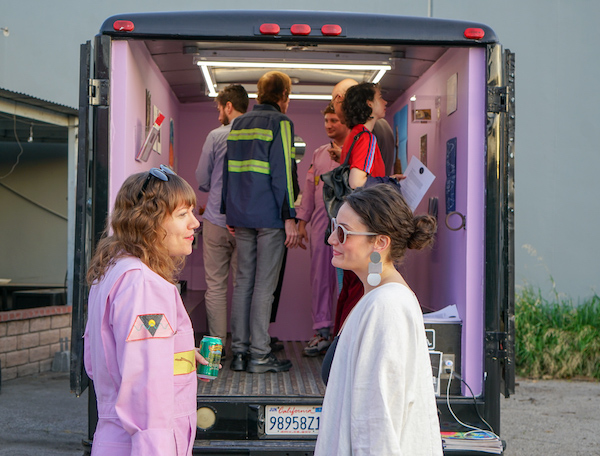Ceci Moss is the director of Gas—a truck gallery that serves as “a mobile autonomous, experimental and networked platform for contemporary art” in Los Angeles. She has worked as the senior editor for the digital archive Rhizome and her impressive curatorial background comes from institutions like Yerba Buena Center for the Arts and The New Museum. In 2019, she published the book Expanded Internet Art: Twenty First Century Artistic Practice and the Informational Millieu.
I spoke with Moss about her book, the recent shift of our entire lives online, and about Gas’ latest program Care Practice: Recipes for Resilience, co-organized with Jenni Nurmenniemi. Our discussion moved from how the art world is adapting in response to COVID-19 to how embodied artistic practice and networked platforms can empower community healing and create avenues of caring for a hurting world.

Bookcover.
SCHULTE: I have to say your book felt like a ray of light during quarantine. Examining how to create meaning in the information milieu and the potentiality of internet art is no longer simply a theoretical and academic concern. It’s on all our radars.
MOSS: That’s the best news I’ve had all week. [Laughs.] Well yes, now everyone is an internet artist!
Anne Boyer, in her essay “Click-Bait Thanatos,” from A Handbook of Disappointed Fate (2018), blames the algorithm “that supersizes our fear and our rage;” she goes on to say: “I am me because my little keywords know me: tagged, geo-located, epigrammatic, identified.” Art on the internet also seems another reminder of containment: trapped in the self, the four walls of our apartment, borders. Do you see any hope of relief in future practices given our present physical limitations?
The pandemic is magnifying all the problems we knew were there, but perhaps remained below the surface. We are in a surveillance state run on data mining. And now that we cannot congregate in public spaces like we used to, we have to ask what it means that our most meaningful connections with friends, family, are happening on for-profit digital platforms. I hope artists create new platforms for engagement. I don’t want to be on Instagram Live for eternity. Eyebeam, a New York-based organization for artists to engage society’s relationship with digital technology, recently did an open call to develop alternative platforms. I am really curious to see how this initiative takes shape.
In your book, you speak of expanded internet art’s non-resolved working through, replicating the somatic experience of the present moment. Curation, with this immersive aspect, resists optimization. How do we resist?
The future of the art world is about innovative platforms, but not for optimization to serve corporations. We need additional pipelines for gathering that have the same power of connectivity as Instagram, without the profit motivation. I’ve been following all the recent events, George Floyd’s horrific murder, and the subsequent demonstrations closely. It’s May 29, and I was up all night on Twitter following threads about the Black Lives Matter protests in Minneapolis, and the organizing that is happening around the US. With the added threat of COVID-19, I’m attuned to the enormous risk people are taking to congregate and speak out and be there for one another. New platforms will be needed to address a world that is deeply hurting, and seeking change.

Ceci Moss portrait.
It makes me think of something I heard Angela Davis say recently; she reminded us that demonstrations are rehearsals for the revolution. It seems this idea of care rehearsals among artists is embedded in feminist revolutionary work and activism. In 2018, you curated a show called “Take Care” for Gas. Can you tell me more how you see Care Practice as an extension of that project, the inspiration behind it, and what participants can expect?
Out of all the essays and work I was reading responding to COVID-19 I was most affected and inspired by Johanna Hedva’s “Get Well Soon;” a part of Sam Lavigne and Tega Brain’s archive of well-wishes from gofundme.com—an archive they note “that shouldn’t exist.” She stresses the idea of care insisting on itself. During quarantine, I’ve zoomed into all sorts of events, from meditation to movement-based classes, drag shows, etc. But I found most of the art talks were simply YouTube videos with artists talking about their art. And although I want to hear artists talking about their art, I was left dissatisfied with the one-way discourse, and it left me feeling even more separated from my community. As a feminist curator, I’m interested in having actual dialogues.
Jenni and I met during a month-long residency I did in Helsinki through HIAP (Helsinki International Artist Programme). We applied to the Finnish Cultural and Academic Institutes’ “Together-Alone” cross-cultural initiative. We wanted to intentionally create space for connections, to organically facilitate moments for sharing, moments that matter so much to me, in these new parameters. It’s been an incredible chance to work with artists we’ve always wanted to collaborate with.


